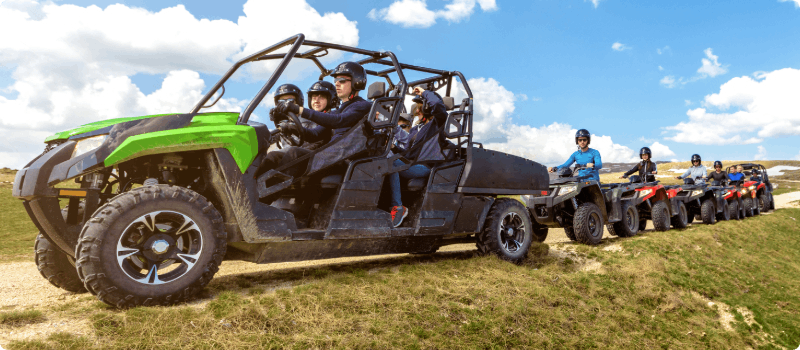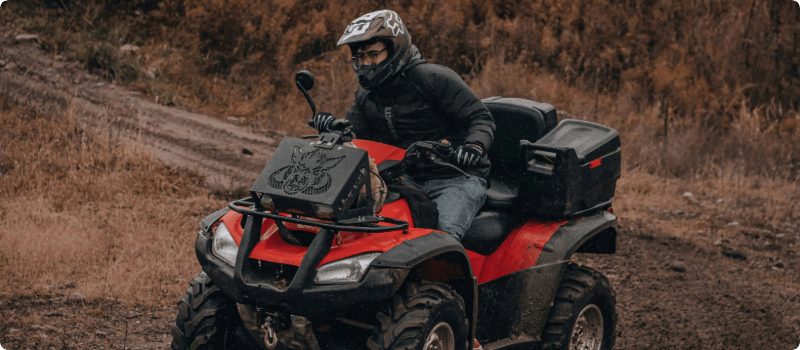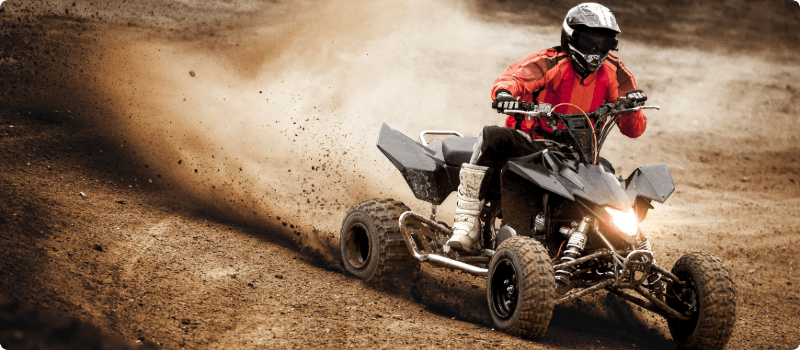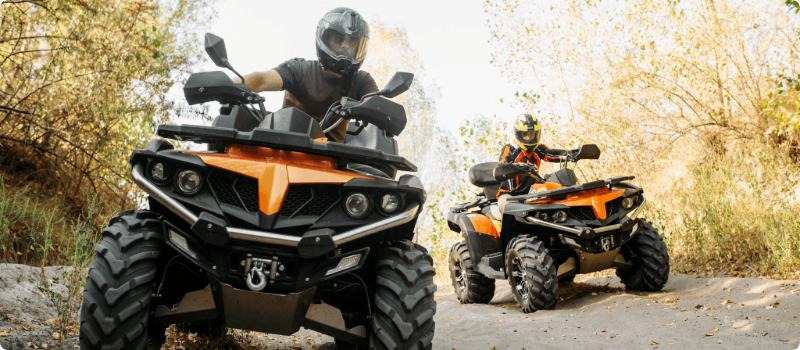Great ATV Riding Tips for Beginners
Updated May 21, 2024 . AmFam Team
If you’re new to ATVs, there’s a lot to learn before you fire up your ride and hit the trails. To make sure you’re doing things right on each new adventure, it’s really important that you educate yourself. By getting familiar with ATV riding best practices, you’ll be ready to hit the ground running! Take a look at these ATV safety tips — you’ll find our riding advice for beginners can make 4-wheeling safe and fun.

Know Your ATV Safety Basics
Common sense goes a long way when you’re on your ATV — and it’s a great place to begin. When just starting out, keep it simple and get to know your ride over time. Here are a few good ideas that can make your ATV experience a safe one:
Start with a simple machine. Picking up a high-performance ride may sound fun, but too much power can be bad. The last thing you need is to lose control of your ATV early on.
Check out the owner’s manual. You’ll be able to pinpoint what items are where and find out how to operate your vehicle the right way.

Educate yourself first. Before you fire up your all-terrain vehicle, invest a few hours in hands-on ATV safety training. The ATV Safety Institute (Opens in a new tab) is a great place to start. Each RiderCourse offers thorough ATV training, and some states offer training subsidies, so check with your DMV. If you’ve recently purchased your ATV, training may be free.
Make sure you have solid footing. As a new rider, you’ll have enough to think about without worrying about what to do with your feet. With Nerf bars and heel guards, you’ll get the stability you need.
Nerf bars are like giant foot pegs that allow you to keep your feet planted during your ride. Heel guards keep your feet where you want them, giving you more control while riding.
Stay off the street. ATVs are typically licensed for “off-highway” use and are not safe or designed to be driven on certain pavements. Also, it may be illegal. Check with your DMV to learn about ATV restrictions in your area.

Learning the Throttle on Your ATV
Bring along an experienced friend, riding on another ATV, who can coach you along the way. Stay aware and get a feel for the way your ride accelerates. Take a look at our ATV throttle tips:
Go slowly at first. The accelerator on an ATV is actually a thumb throttle that you press. Getting the feel of the throttle is important for new riders to help build confidence. Giving it too much gas can cause the ATV’s front end to pop up. Practice easing the throttle on and you’ll be riding safe and stable.
Purchase high-test gasoline. Filling up with high-octane fuel can keep your machine running smoother, longer. Your throttle will perform more consistently too.

Always Wear Your ATV Riding Gear
Having the right gear can make a big difference and being prepared is one great way to prevent serious injuries. Here are a few key points about ATV riding gear:
Wear protective clothing. As a new rider, you should invest in all the necessary protective clothing and gear you need. Make sure you have a protective jacket, good boots that go above your ankle, a DOT-certified helmet, gloves and goggles. Don’t forget a chest protector and knee/shin guards for further protection.
Get a good helmet. When you’re moving fast down the trail, ducking branches and catching dirt from the ride in front of you, you’ll be glad you invested in a good DOT-certified helmet. They’re the single most effective means of preventing head injuries.
Off-road/Motocross helmets offer full-face protection and a solid section of molding that protects your chin and jaw. They also cut down on noise and protect you from flying insects.

Learn About ATV Shifting
Depending on the type of ATV you’ve got, you may have to ramp up on manual shifting. Usually, the left foot will control the shifting lever and the left hand controls the clutch. Your right thumb will typically manage your speed with a spring-loaded throttle.
You’ll find there’s a finesse to managing the throttle and the release of the clutch to prevent stalling. Here are a few other ATV transmission tips:
Practice changing gears. If anyone ever taught you how to drive a stick shift, they probably took you to a parking lot and you practiced working the clutch and shifting gears over and over until you felt confident. This same lesson should apply to new ATV riders.
Make your controls second nature. Over time, your ATV’s gearing and controls will become familiar. But in the beginning, they’re easy to confuse. So, practice with all your controls until you’re very comfortable before you go on any long-distance treks.

ATV Posture and Riding Positions
Good ATV posture can help you to feel balanced and in control when riding. Simply keeping your feet planted and your hands firmly gripping the handles at all times can prevent injury. Here are a few other ATV posture tips:
Work on your riding position. While an ATV has handlebars like a dirt bike, steering an ATV is different. You’ll still use your body to help distribute weight evenly.
But while you’d lean into a curve on a dirt bike, on an ATV you lean to the opposite side of momentum. So, if you're turning right, you'll feel pushed to the left and you'll want to lean right.
Know when to hover. When you’re on a flat trail enjoying the sights, go ahead and sit down. But if you're picking up speed on a livelier trail you’ll need to stand up.
Remain just above the seat, with your elbows out and knees bent and enjoy the ride. Hovering gives you greater visibility and will end up making you a better rider.
Stay loose. Remember that you’re riding on terrain that can have unexpected bumps and dips. Avoid locking your elbows, and keep your knees bent to absorb the movement along the way.

ATV Practice Makes Perfect
Mastering a skill like riding an ATV will take time. Here are a few tips on mastering the art of riding your ATV:
Deliberate practice is key. Start your practice rides with a goal. By working with realistic expectations, you’ll make steady progress.
Practice by isolating tasks. Refer to your training and work on improving your skill by revisiting situations that gave you trouble in the past. Approach these passes carefully and remember that quality over quantity yields the best results.
Becoming a skilled rider and feeling confident comes with time. To master the basics just suit up and practice on various terrains. As you slowly increase your skill, you’ll find your coordination and riding abilities will improve, and you’ll experience real 4-wheeling fun.
While you’re getting comfortable on your ATV, remember to get in contact with your American Family Insurance agent. Be sure to inquire about ATV insurance, additional ATV coverages and ATV coverage discounts for increased protection. You’ll ride with more confidence knowing that your ATV’s covered, no matter where the trail ahead takes you.
This article is for informational purposes only and includes information widely available through different sources. This article does not afford, offer, or guarantee any coverage.
Tools & Resources
NextScripts
JSS component is missing React implementation. See the developer console for more information.

